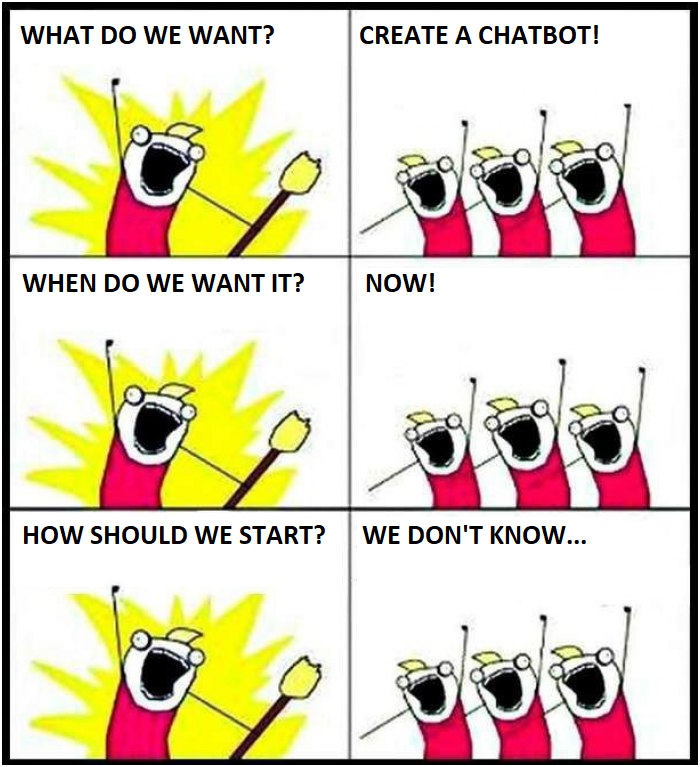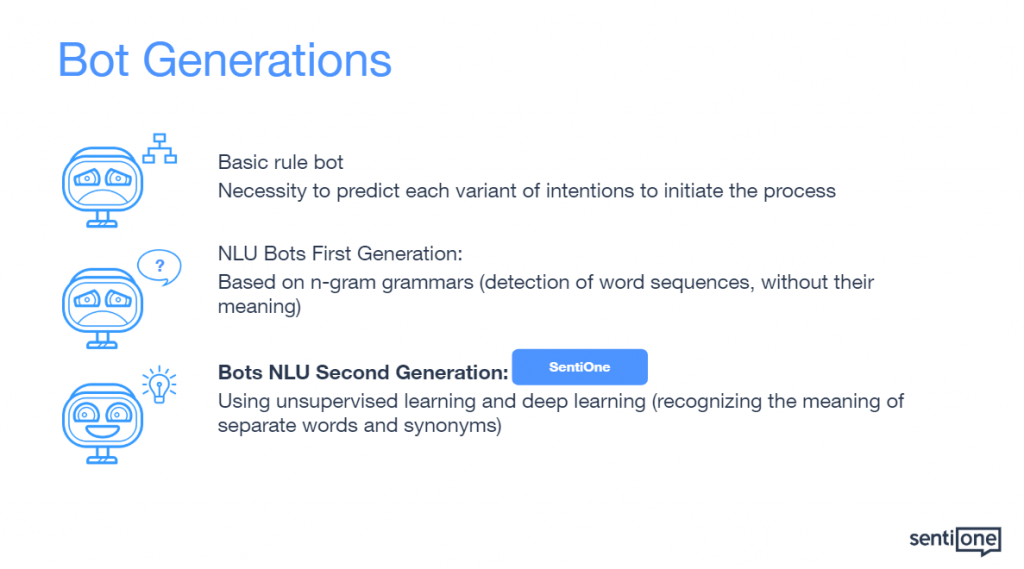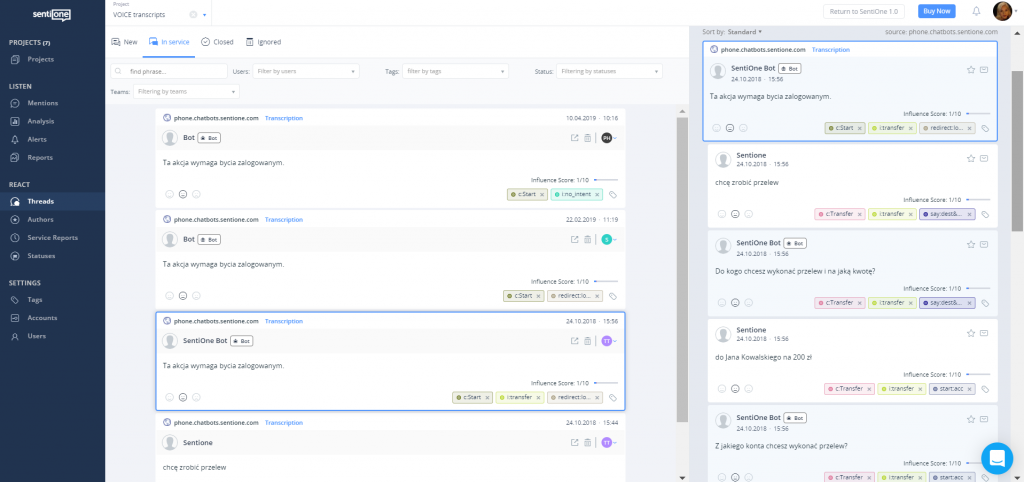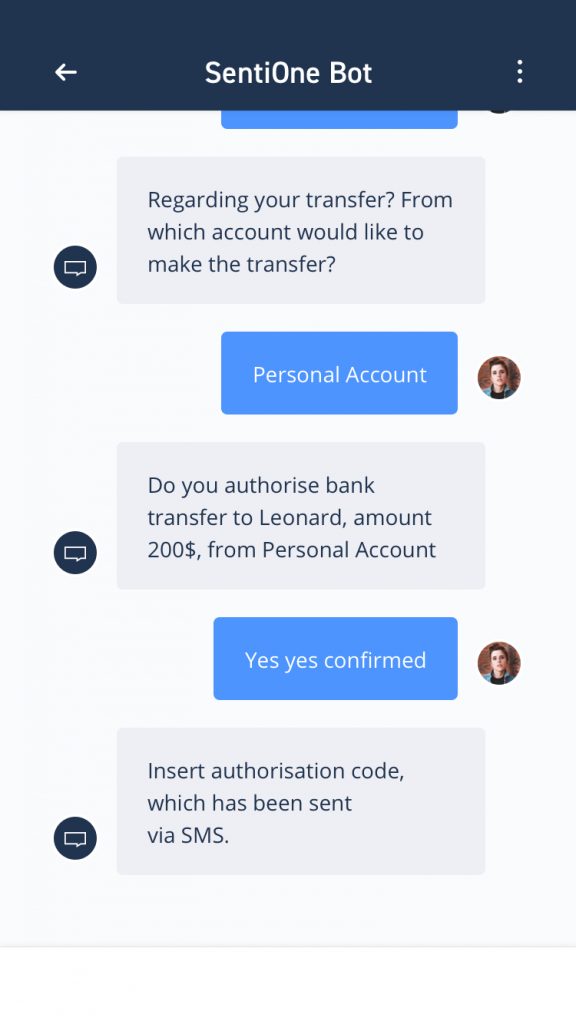How to avoid these 5 common mistakes when creating a chatbot
The popularity of chatbots in business is increasing day by day, but for many companies, this subject still remains one big mystery.
In short, companies would like to, and yet they are afraid.
It often starts with a general concept…

Of course, the general idea of getting into the chatbot business is all fine, but people seem to be confused about where to start and how to prepare a plan for the implementation. As technology advances, customers’ needs change faster and faster. Next generations expect companies to be available for online contact. If, as a company, you limit communication to the call centre, email or a form on the website, you can be sure that sooner or later you will be far behind the competition.
Most agencies already know how to plan a social media strategy, when to post, how to communicate with users, how to respond to crisis situations. Besides, brands (aka the clients) know what to expect from an agency and how to evaluate the work of strategists and social media administrators. However, for both sides, the topic of chatbots may not be so well known, and in this situation is easy to make simple mistakes.
In this article, I will try to clear out a bit what mistakes to avoid when implementing the first chatbot. I hope that thanks to this you will be able to answer the question “where to start?”, and thus you will be able to efficiently implement a bot meeting the business needs of your company.
What is a bot?
Bots are computer programs that are able to replace people by simulating the actions of live users. At the man’s command, they are able to perform many more or less complex activities. The very name “bot” is short for the robot.
Bots are designed to facilitate our lives more and more, reduce the costs of businesses, make it possible to redirect human resources to more creative and more advanced tasks. The bots mentioned in this article are mainly chatbots used to communicate with customers in online channels (eg social media, on-site chat) and voicebots (eg helpline, call centre).
The list of the most common mistakes made when creating a bot
- Imprecise objectives for the chatbot implementation
- Imprecise metrics (KPIs)
- Lack of idea for the bot persona
- Organisational and/or communication problems within the implementation team
- Choosing an incompetent technology partner or supplier
1. Imprecise objectives for the chatbot implementation
Answer the question: what goals do you want to achieve with your bot?
The starting point should always be the answer to the question: how can a bot support my business?
The key goals of using bots are:
- customer service automation (reduced costs, improved standards, and performance)
- increasing sales
- improvement or change of the brand image
- providing entertainment
Process optimisation and customer engagement
A bot can, for example, improve the handling of certain processes (eg by collecting data in the form, accepting orders, assisting with the application submission or accepting a complaint). It can also answer the most frequently asked questions and thus relieve the customer service team significantly (it is estimated that up to 70% of repetitive processes can be serviced by chatbots).
For example, the voicebot can replace the classic IVR and make the initial selection of calling customers. Another function that a bot can be applicable to is supporting the brand image, dealing with a competition or a simple social media campaign.
Finally, it’s worth mentioning bots that do not really serve anything other than engaging audiences and providing entertainment to users. An example may be chatbot on the “Who wants to be a Millionaire” Facebook Page, which allowed users to take part in a virtual game (it was, of course, an element of a promotional campaign on the occasion of reactivation of the popular program).
Customer service personalisation
A good idea is to find a balance between business and personal relations. If we want to increase the sales of our products, let’s try, for example, to tell the customer which product will be right for them. In perfumes or cosmetics market, a great idea will be a chatbot that can conduct an interview with the user and tell them what product will be perfect for them or as a gift for a loved one. The problem with the choice of wine can be facilitated by a bot specialising in pairing the beverage to food and preferences. I guarantee that the customer will be much more likely to buy a product that has been personally tailored to their needs than a product advertised only by a general message to the general public.
Only if we define the scope and purpose of the bot, we will be able to decide what kind of bot will be suitable for our business. We have a whole range of solutions to choose from. Depending on the channel, we can plan a chatbot (chat, messenger) or voicebot (call centre, helpline). To make the right decision, verify which channels your clients use most often and in which channels the scale of the problem you plan to solve is the most significant.
Did you know?
The most popular instant messengers on a global scale are undoubtedly Facebook Messenger and WhatsApp. According to information provided by Facebook at the F8 conference in 2018, over 300,000 chatbots are already active on Messenger (three times more than in the previous year). Interestingly, Whatsapp has opened its API to business clients, which means that brands can support this channel from other tools that integrate messages from various places, such as SentiOne React.
Examples of chatbot applications in different channels:
- Facebook Messenger – moderation support, FAQ service, contest/promotion campaign support, process support, fast response in case of failure/crisis with increased message volume
- Chat on the website – FAQ service, process support available on the website, demo scheduling
- Call centre – initial recognition of the topic of conversation, FAQ service, debt collection, satisfaction surveys, process support (eg client identification and log-in process)
Types of bots
In most cases, a simple bot might be a sufficient solution to achieve the expected business goals. When writing about simple bots, I mean the ones that, when in a conversation with the customer, give them several predefined answers in the form of buttons to choose.
A bit more developed solution will be rule-based bots that can recognise specific messages (unfortunately this means a lot of human work, because these messages must be entered manually first).
The most advanced conversational bots are based on innovative solutions such as AI (artificial intelligence), NLU (natural language understanding) or ML (machine learning). They make it easy (from the point of view of the person configuring the bot) and effectively to train the bot to recognise the customer intentions, even if they are formulated in many different ways. Thanks to new technologies, bots are able to remember data and develop without human interference.

Of course, this last type of bots is able to guarantee us the biggest “wow” effect in the eyes of customers.
Currently, most brands are aware that the key to success is to improve the customer experience. The use of innovative solutions, and thus the addition of an element of (positive) surprise in contact will certainly result in customer satisfaction. Such bots also give us the greatest opportunities. They make interaction with brands more effective, personal and satisfying.
Conversational AI bots can, of course, be combined with “clicked” bots. Often this solution is the most optimal because it eliminates some of the errors that the bot can make when recognising intentions. Users can also feel more confident in contact with such a bot because they know that they can easily switch to a consultant at any time.
If you still do not know what bot you need, such tools as SentiOne come to your aid. Thanks to online listening and data analytics, you will find out what problems your clients report most often, what topics of conversation are most often repeated, what is their volume. Data obtained from the internet monitoring also constitute an excellent training base for the bot, necessary to define the processes and intentions recognised by the bot.
2. Imprecise metrics (KPIs)
Answer the question: how do you want to measure the effectiveness of the bot?
If you want to be sure that your bot brings measurable benefits to our company, you need to know how to evaluate its work. Depending on the type of bot, the indicators may be very different. If you do not specify them properly or they are too imprecise, you may have a problem with determining whether the implementation of the bot was a good idea and whether the effectiveness and operation of the bot is consistent with our assumptions and expectations.
Appropriate measurements are also necessary for making corrections and effective optimisation of the bot.
How to measure the effectiveness of chatbots?
Below you will find some ideas that may work for your bots or inspire you to analyse how the bot works in general.
Customer service bots
-
- Level of automation – the most general indicator (eg number/per cent of customer queries served compared to all queries)
- Reduced response time – comparison of response time to customer inquiries before and after implementation of the bot
- Reduced customer service time per process (from filing the query to solving the case) – comparison of the average time of handling requests before and after the implementation of the bot
- Support for a larger volume of queries – the number of served requests before and after implementation of the bot
- Accuracy of the bot – the ratio of correctly recognized intentions to the misidentified or unrecognized intentions
- Streamlining the process (shortening paths, shortening the process duration, fewer problems reported by clients)
- Customer satisfaction survey – a quantitative and qualitative survey addressed to clients contacting the bot
- The volume of applications in other channels – if we implement the bot for example on Messenger, it is worth checking whether by chance clients started migrating to other channels, avoiding contact with the bot (of course, the opposite may be true – clients may consider talking to a bot more effective or more attractive and thus give up the use of other contact channels
Sales bots
-
- Increased sales – comparison of sales before and after implementation of the bot (number of clients, transactions, revenue)
- Increased traffic on the website – compare the number of unique entries to the site before and after the implementation of the bot
- Increased number of leads – the actual number of people signed up for the trial version or meeting with the help of the bot
Entertainment bots
-
- Increased website traffic
- The sentiment of customer opinions – comparison of negative and positive opinions about our brand before and after implementation of the bot
- Qualitative analysis of opinions about our brand and about the bot itself
- Increased number of mentions (buzz) about our brand
How online listening can help to analyse the effectiveness of the bot?
Thanks to the tools developed for monitoring the internet statements, such as SentiOne, we can easily verify changes in the number of brand mentions, their sentiment, and also take a closer look at the clients’ opinions to find out how customers react to the presence of the bot. Bots implemented by SentiOne are integrated with the Speech Analytics and Reporting module, which allows real-time analysis of the bot’s work and the correctness of the intent recognition effectiveness.

If we can determine which indicators are the most valuable, it is very important to plan in detail how they will be measured. The analysis plan should be prepared before starting the bot so that you can verify its operation from the very beginning. The better we plan the analysis, the more reliable it will be (you will not have to make any modifications in this regard during the project).
Remember!
You cannot improve something that is not measured in any way! So never make a deal with a bot supplier who will not provide you with information on how the bot works after implementation and the tool enabling its further development and optimization.
3. Lack of idea for the bot persona
Answer the question: what should your bot be like?
The character or the persona of the bot is a very important element, which we should remember at the very beginning when planning implementation. It should come primarily out of the bot’s purpose, tasks to be met by the bot, the communication strategy, the image of our brand, and the nature of our target group.
The most secure but also the least attractive choice will be the neutral personality of the bot. A neutral bot does not show any particular character traits. He behaves politely, courteously, but with detachment. If the communication strategy of our brand allows it, it is worth using the help of the creative department and creating a bot that will not only stand out in the market but also make it easier for clients to make contact with our company.
Why is it worth creating the right bot persona?
One of the biggest advantages of talking to a bot is its unlimited availability with no pressure at all. Instead of calling a helpline serviced by consultants, the customer can write to the bot in one of the preferred online channels. Thanks to this, the customer doesn’t have to spend time “hanging on the handset” and waiting for the agent to answer the call. The customer can pause the conversation and return at a convenient time. That is why it is important that the language and personality of the bot should also encourage customers to feel free to contact it.
A bot can act as a virtual adviser or assistant. Practice shows that its language should be as natural and “human” as possible so that the conversation seems natural and does not differ too much from talking to a consultant. Even if you inform clients that the conversation is run by a bot (you should remember to do so), you should try to give as many human characteristics as possible to the bot’s statements. Regardless of whether you decide to give a colourful personality to the bot or not, you can be sure that it will be given by the users themselves (even if you decide on the simplest chatbot solutions).
Key elements of the bot persona
When planning the personality of your bot, begin by segmenting your target audience and determining their expectations, lifestyle, language style, etc. Then you should choose a name for the bot, which in itself will outline its character. Both the name and the features that you choose should best reflect the nature of your company and industry. The gender of the bot should also be well thought through. Unfortunately, stereotypes functioning in our society can often be a good direction here.
For example, creating a bot for the automotive industry, we can assume that a male bot will be a better choice. Without diminishing women, as a rule, men are more passionate about automotive topics, so the choice of a “male” bot may affect the increase of his authority. On the other hand, we can create a bot that tells customers what to wear or what cosmetics to choose for their type of beauty. Here, a more specialist in the eyes of users can be a “feminine” bot. Of course, we do not always have to be biased like this – we can even try to break the rule! The most important is the original idea, creativity and comprehensive planning of the bot from A to Z.
There are also interesting tools available on the internet that can help you estimate the personality based on the completed test. For this you need to design a bot character, eg specify what role it plays in your company, its position, gender, name, etc. Then answer the test questions, trying to think like a bot.
Another very important element to remember when designing a bot persona is the “small talk” functionality. These are topics that do not directly refer to the bot’s field of expertise. These are the answers to the most unobvious but also very common questions such as how old are you? what do you like doing? what movie do you recommend?, etc.

To sum up, the basic elements of creating a chatbot personality are:
- the caller (your target group),
- bot’s name and gender,
- the role of the bot in the company,
- style of expression.
It is worth remembering that not every bot-making company includes in its offer preparation and customisation of the bot’s persona to our needs. Therefore, when starting a deal with a supplier, it is good to raise the subject, in order to make sure that there are an external agency or marketing specialists within our company included in the project.
4. Organisational and/or communication problems within the implementation team
Answer the question: how to build a successful team responsible for implementing the bot?
When implementing the bot, it is very important that the implementation teams on both sides (the client’s and the supplier’s) work closely together. In the case of more advanced projects, it is worth planning regular meetings, which will definitely improve the knowledge sharing, and thus the development and improvement of the bot itself.
In each team, it is necessary to identify the person responsible for the project, which will be the first line of contact, as well as the decision-maker. Depending on the type of bot, the team should include specialists from customer service, marketing, and sales. In addition to the support at the stage of creating the bot, later on, they should evaluate the bot’s effectiveness. It is good practice to prepare precise documentation for the project and to point out all issues that may require consultation or high-level decisions to be made.
Let’s take for instance creating the bot persona – in this case, it may be necessary to work with the marketing or communications department, who will probably be decision-makers. If you forget about including them at the right time, the bot launch might be blocked. The biggest threat posed by poor organisation of work is unnecessarily prolonged decision process.
Despite the need to involve all the needed people, it is worth remembering that the entire team should not be too big (the fewer people, the faster decisions will be made, and the cooperation will be much more efficient).
5. Choosing an incompetent technology partner or supplier
Answer the question: what do you expect from a bot supplier?
If you already know what to remember about creating a bot, choosing the right supplier should be much easier.
In the case of customer service bots, we focus mainly on the effectiveness of the technological solution (the effectiveness of recognising intentions, recognising the context of the statement), therefore, hiring a marketing agency to build a bot may prove ineffective. It this case, it is better to establish cooperation with a company that will provide the technology, and decisions regarding, for example, a simple persona bot will be made inside your company, with the participation of your marketing team.
However, if you want your bot to have a unique, extraordinary personality, it is worth hiring specialists. In this situation, you can establish close cooperation between your team and the team on the side of the marketing agency (creative ideas, design) and the bot supplier (technology).
If your priority for the bot is for it to be surprising, the most important factor will be creativity. From the technological side, it is worth choosing a partner who will offer the most flexible and scalable solutions – thanks to this you will limit the amount of human work, and thus the long-term costs of implementing, optimising and maintaining the bot. Remember that if you want to do something really spectacular, it is sometimes worth taking a risk, because the technology is developing fast enough that simple rule bots may seem a little outdated (especially in a few years).
The choice of bot provider is just as important as choosing an agency. If in a conversation with a potential supplier there are no such topics as analysing the effectiveness of the bot or its persona, it may be better to look further.
It is also worth paying attention to the complexity of the offer. The provider, who specialises in various types of bots (voicebots, chatbots) and applies the most advanced technologies like machine learning, NLU, will give you more room to improve in the future and a better guarantee of success.
Remember that the best chatbots are created thanks to creative ideas and advanced technology.
Customer service automation at your hand
Finally, I would like to emphasize again that the most important thing is to set a goal for the bot, set performance indicators (KPIs) and choose the best supplier for the expected solution.
At SentiOne, we implement bots that automate customer service at a very advanced level, using a unique NLU engine for identifying intentions built thanks to many years of experience in data analysis and natural language processing. If you want to know more, please contact us.



